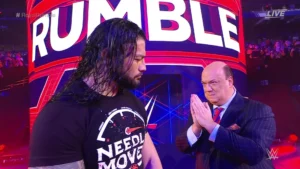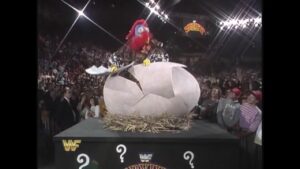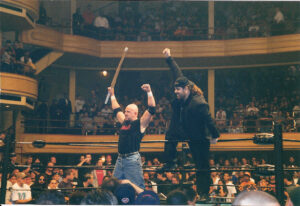The Royal Rumble has been an annual tradition in the WWE since it first debuted at a WWE Live Event in Hamilton, Ontario, Canada on January 24, 1988. While it was not televised as a Pay-Per-View, it was broadcast as a special on the USA Network, which saw “Hacksaw” Jim Duggan last eliminating One Man Gang to win the first-ever Rumble event. The following year, the Royal Rumble became one of the Big Four in the WWE’s Pay-Per-View schedule and has ever since. In 1993, the added stipulation that the winner of the Rumble would earn a world title shot at the upcoming WrestleMania was introduced, and the Royal Rumble has adhered to that concept ever since (barring the 2016 Rumble where Roman Reigns had to defend his WWE Championship during the match).
But in 1994, WWE actually held two Royal Rumble events – the one everyone knows of is the one televised on PPV that saw Bret “Hitman” Hart and Lex Luger both co-win the event, leading to up to WrestleMania 10. But five days prior to the Royal Rumble PPV, the whole world watched; WWE held another Royal Rumble at Madison Square Garden in New York City. The show is best remembered as the night that The Quebecers (Jacques Rougeau & Pierre Carl “PCO” Ouellette) defeated Marty Jannetty & The 1-2-3 Kid for their first reign as WWF World Tag Team Champions, but it was also a secret experiment that would set the stage for the next few months of storytelling – the rise of Owen Hart as a potential main event superstar in the WWF.

Since returning to the WWF in late 1991, Owen Hart has mostly been relegated to tag team action. First, he was paired with brother-in-law Jim “The Anvil” Neidhart in The New Foundation, before switching partners to Koko B. Ware in the tandem High Energy. By the spring of 1993, High Energy was no more and Owen Hart was slowly added into the singles division again. While his older brother Bret was already a main event star in the WWF, having just finished his first reign as WWF World Heavyweight Champion after two impressive stints as WWF Intercontinental Champion, Owen Hart found himself facing enhancement talents on WWF television. Usually, however, Owen ended up on the short end of the stick when he faced bigger names like Lex Luger or…Mr. Hughes?
On the Live Event (house show) circuit, he was routinely facing the likes of “Red Rooster” Terry Taylor, Damien DeMento, Blake Beverly, and Bastion Booger – not exactly the kinds of names that would elevate Owen anywhere near his Bret’s stratosphere. In October, he would unite with Bret in tag team action, defeating the team Well Dunn (Steven Dunn & Timothy Well) on WWF Wrestling Challenge. That November, he’d be part of the Hart Family team at Survivor Series, where he joined Bret and other older brothers Bruce and Keith in defeating Shawn Michaels‘ squad. Following Survivor Series, Owen’s temper began to show – he blamed Bret for causing Owen’s elimination in the match, and challenged his brother to a match; Bret refused. The seeds of jealousy were now planted in Owen’s eyes.

But while he had his brother in his sights, Owen continued to face lesser card opponents (mostly Bastion Booger). Then, on January 17, 1994, in Madison Square Garden, Owen was given his biggest moment thus far in the WWF – despite no one but the 9,000 fans in attendance seeing it. With only a week to go until the Royal Rumble PPV, WWF put on a special one-night Royal Rumble event in New York City. Apart from the WWF World Tag Team Title change, WWF World Champion Yokozuna defended his title against Tatanka, Razor Ramon defended his WWF Intercontinental Championship against Jeff Jarrett, while another prospect Ludvig Borga faced off against Rick Steiner. The main event of the evening was a special Royal Rumble match, full of a huge roster of talents. The first two entrants were Diesel (Kevin Nash) and Mo (from Men on a Mission), and the Rumble was off!
The Rumble saw multiple legends and Hall of Famers enter the contest, including “Macho Man” Randy Savage, Shawn Michaels, Scott Steiner, Bam Bam Bigelow, Rick Martel, 1-2-3 Kid, Sgt. Slaughter, Virgil, and Bob Backlund, with Owen Hart entering the Rumble at #20. Upon his entry, he was targeted by Crush (Brian Adams). When “The Model” Rick Martel showed up at #21, the two heels double-teamed the youngest Hart brother. At #22, Bret Hart entered the Rumble, and the two Hart brothers teamed together to fight back their opposition. By the end of the Rumble, the Final Four were Bret, Owen, Shawn, and Headshrinker Fatu (Rikishi) – oddly enough, if you substitute Luger with Owen, you’d get the same Final Four at the Royal Rumble the following week.
Bret and Fatu were working on each other, but just as Bret almost had Fatu over the ropes, Michaels would sneak up on the Hitman, eliminating Bret and leaving Owen alone with two opponents. As soon as Michaels hit his Sweet Chin Music on Owen, Razor Ramon came down to ringside – Shawn had interfered in Razor’s IC title match earlier that night – and began to chatter at Michaels. Owen rebounded and attacked Fatu, sending him into the ropes. Fatu hit a distracted Michaels, his back turned as he was yelling at Razor, sending the Heartbreak Kid out of the ring. It was now down to Owen Hart and Fatu and soon Headshrinker Samu came down to ringside to watch over his partner, which prompted Bret to return to even the odds. Ultimately, Owen would send Fatu over the top rope with a dropkick, winning the Royal Rumble, and celebrated in the ring alongside Bret Hart to a raucous New York City audience.
By all accounts, the New York City Royal Rumble on January 17, 1994 was designed solely to see the reaction Owen Hart would get as a main event player. By all signs, it impressed the men in charge, particularly Vince McMahon. The following week, after Bret and Owen lost in their challenge for the WWF World Tag Team Titles against The Quebecers in the early card for the 1994 Royal Rumble, Owen officially turned heel by turning on his brother following the match. Bret had injured his leg during the match and the match was finally called by the ref due to his injury. Upset that Bret never tagged Owen in to save the match, Owen turned on his brother and attacked his injured leg. Despite the attack, Bret would still enter the Rumble later that evening, where he would co-win when he and Luger were both eliminated at the same time, each touching the floor at the same moment.
Following the Rumble, Owen demanded a match against Bret, to prove once and fall all he was the superior Hart brother in the WWF. After losing a coin toss to see who would face WWF World Champion Yokozuna first at WrestleMania 10, Bret was officially booked to face Owen in the opening event. That match would go down as one of the most acclaimed matches in WrestleMania history and provide Owen his biggest victory ever in the WWF. Bret would go on to defeat Yokozuna at the end of the night for his second WWF World Championship, and from March of 1994 until August, he would face his brother dozens of times on WWE Live Events, and constantly chasing his brother’s world title on television. In June, he won the King of the Ring, which only amplified Owen’s new heel persona, and at SummerSlam ’94, Owen finally faced his brother for the WWF World title in a cage match that is still revered to this day.
The amazing run from Owen Hart in 1994 helped cement him as one of the WWF’s very best in-ring workers who had grown incredibly adept at working with any style to create a fun and inspired match. He would become one of the WWF’s true gatekeepers, anchoring the top of the mid-card with his own reign as WWF Intercontinental Champion, while facing many of the names who would go on to become main event legends, such as Rocky Maivia (en route to becoming The Rock), “Stone Cold” Steve Austin, Hunter Hearst Helmsley (before becoming Triple H), and Mick Foley (as Dude Love).
He would still have frequent World championship matches – he faced Diesel in 1995, Shawn Michaels in 1996 (at In Your House 6: Rage in the Cage) and in 1997 on Monday Night RAW following the Montreal Screwjob. He would eventually reunite with Bret in 1997 as part of the new Hart Foundation, alongside Neidhart, another brother-in-law British Bulldog and family friend Brian Pillman, and following his brother’s departure following Survivor Series ’97, he remained one of WWF’s top stars until his tragic passing in 1999. He was a continued gatekeeper in the WWF until his passing; one of his last matches was a dark match at a WWF Shotgun Saturday Night taping, where he was helping prep a young Kurt Angle for his WWF debut.

One of WWF’s most underrated and unsung heroes of the 1990s and into the Attitude Era, Owen Hart’s ascension to becoming one of wrestling’s most beloved figures was certified with a virtually unseen Royal Rumble win in New York City – his mother’s hometown – in 1994.
Stay tuned to the Last Word on Pro Wrestling for more on this and other stories from around the world of wrestling, as they develop. You can always count on LWOPW to be on top of the major news in the wrestling world, as well as to provide you with analysis, previews, videos, interviews, and editorials on the wrestling world. WWE fan? You can check out an almost unlimited array of WWE content on the WWE Network.
Looking to talk wrestling, pro football, or any number of sports? Head on over to the LWOS Boards to engage in conversation with fellow fans!






